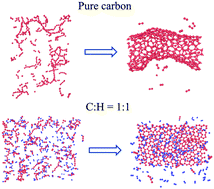Molecular understanding of the effect of hydrogen on graphene growth by plasma-enhanced chemical vapor deposition†
Abstract
Plasma-enhanced chemical vapor deposition (PECVD) provides a low-temperature, highly-efficient, and catalyst-free route to fabricate graphene materials by virtue of the unique properties of plasma. In this paper, we conduct reactive molecular dynamics simulations to theoretically study the detailed growth process of graphene by PECVD at the atomic scale. Hydrocarbon radicals with different carbon/hydrogen (C/H) ratios are employed as dissociated precursors in the plasma environment during the growth process. The simulation results show that hydrogen content in the precursors significantly affects the growth behavior and properties of graphene (e.g., the quality of obtained graphene, which is indicated by the number of hexagonal carbon rings formed in the graphene sheets). Moreover, increasing the content of hydrogen in the precursors is shown to reduce the growth rate of carbon clusters, and prevent the formation of curved carbon structures during the growth process. The findings provide a detailed understanding of the fundamental mechanisms regarding the effects of hydrogen on the growth of graphene in a PECVD process.



 Please wait while we load your content...
Please wait while we load your content...